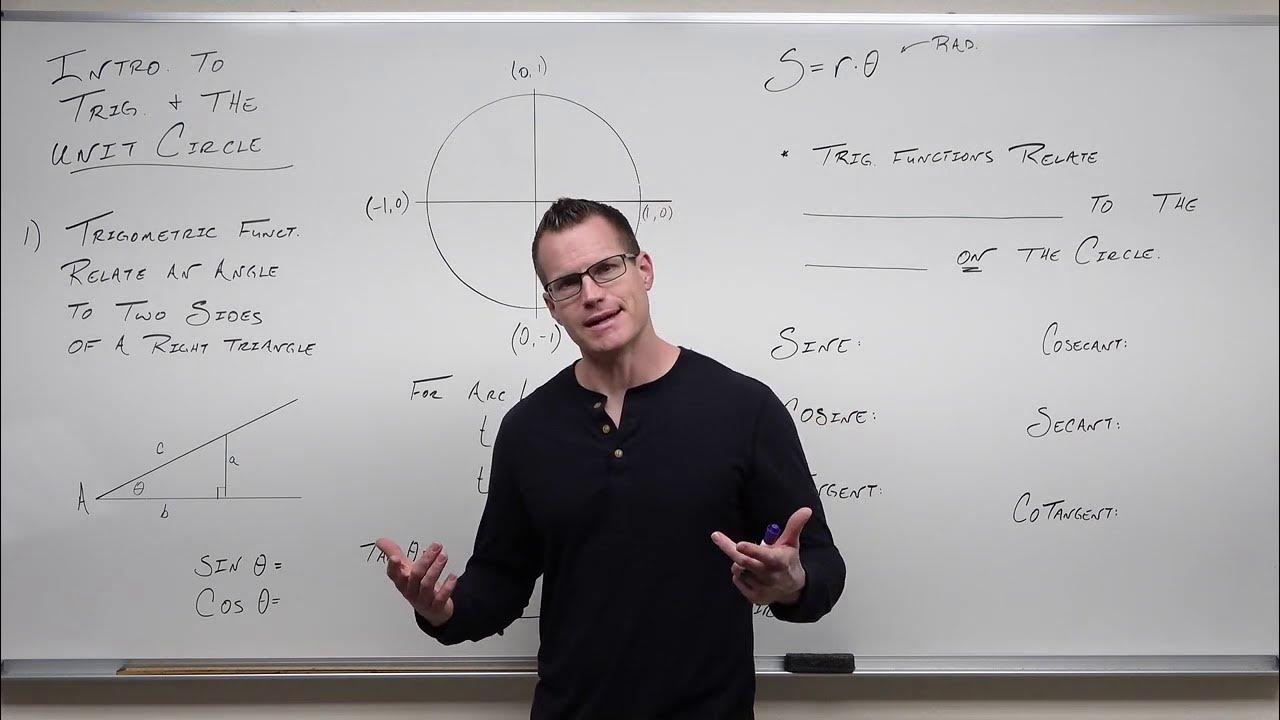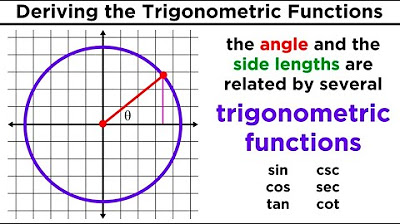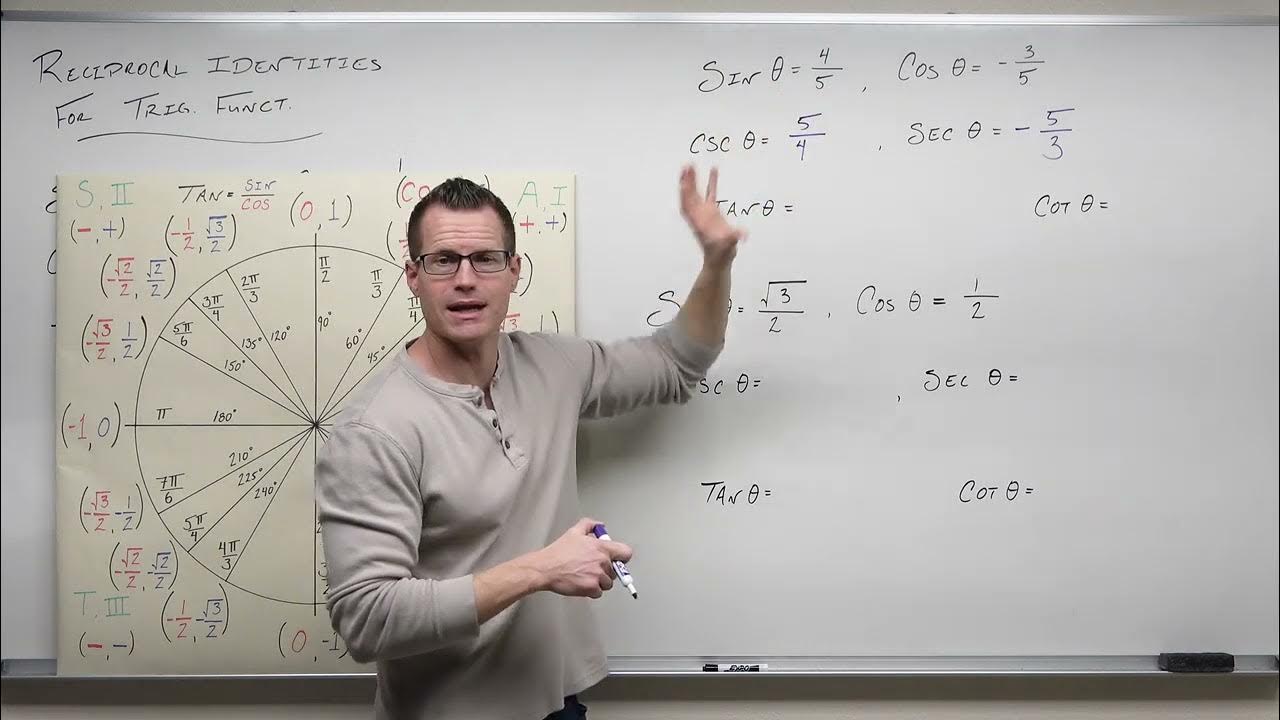Precalc 5.3 Solving Trig Equations
TLDRThis video script covers solving trigonometric equations, focusing on isolating trig functions and finding solutions within specified intervals. Techniques like the hand trick for reference angles and factoring trig functions are discussed, with examples including equations with sine, cosine, tangent, and their reciprocals.
Takeaways
- 📘 Find all solutions for each trig equation and then specify solutions within a given interval.
- 📈 For the equation 4sin²(θ) - 1 = 0, isolate sin(θ) and solve for θ.
- 🔢 When sin²(θ) = 1/4, take the square root to find sin(θ) = ±1/2 and find all angles where y-coordinate is ±1/2.
- 🧮 Use the hand trick to determine that sin(θ) = 1/2 at θ = π/6, 5π/6, 7π/6, and 11π/6.
- 🔄 Since there are infinite solutions, add 2πn to each angle to represent all solutions.
- 📐 For the equation 2cos(x) + √3 = 0, solve for cos(x) and determine the angles where cos(x) = -√3/2 in quadrants 2 and 3.
- 📝 Use the hand trick to find cos(x) = -√3/2 at x = 5π/6 and 7π/6, and add 2πn for all solutions.
- 📏 Solve equations involving multiple angles (like 3x and 2x) by isolating the trig function and using similar methods.
- 🔍 For equations involving cosecant, convert to sine for easier solving.
- 📏 Factor equations with both squared and regular trig functions to solve them.
Q & A
What is the first step in solving the trigonometric equation 4 sin^2(θ) - 1 = 0?
-The first step is to isolate sin(θ) by adding 1 to both sides, resulting in 4 sin^2(θ) = 1, and then dividing both sides by 4 to get sin^2(θ) = 1/4.
How do you find the angles for the equation sin^2(θ) = 1/4?
-You take the square root of both sides, resulting in sin(θ) = ±1/2. Then, you determine the angles in the specified quadrants where the sine function yields these values.
What is the 'hand trick' mentioned in the script, and how is it used to find reference angles in trigonometry?
-The 'hand trick' is a mnemonic device used to remember the signs of trigonometric functions in different quadrants. It helps in quickly determining the reference angles for given trigonometric values.
How many angles are there for the equation 4 sin^2(θ) - 1 = 0, and how are they represented in the solution?
-There are an infinite number of angles for this equation, as it represents a periodic function. The general solution is represented by adding 2πn to each of the four found angles, where n is an integer.
What is the process for solving the equation 2 cos(x) + √3 = 0?
-First, isolate cos(x) by subtracting √3 from both sides and then dividing by 2, resulting in cos(x) = -√3/2. Then, find the reference angle and the corresponding angles in the correct quadrants.
How does the script approach solving equations with cosecant (csc)?
-The script suggests converting cosecant to its reciprocal, which is sine, to simplify the problem. For example, if csc(θ) = √2, then sin(θ) = 1/√2.
What is the reference angle for the equation csc(θ) = √2?
-The reference angle for this equation is π/4, as the sine function equals √2/2 at π/4 radians.
How does the script handle equations with tangent (tan)?
-The script identifies the quadrants where tangent is negative (second and fourth quadrants) and finds the reference angle where the ratio of y to x is the given tangent value.
What is the reference angle for the equation tan(θ) = √3?
-The reference angle for this equation is π/3, as the tangent function equals √3 at π/3 radians.
How does the script solve trigonometric equations with squared functions, like sin^2(x)?
-The script suggests factoring the equation, treating the squared trigonometric function as a quadratic equation in terms of the trigonometric function.
What is the general solution for the equation sin^3(x) - sin(x) = 0 within the interval from 0 to 2π?
-The general solution involves finding the angles where sin(x) = 0, sin(x) = 1, and sin(x) = -1 within the specified interval, without extending the solution to include all periodic angles.
Outlines
📚 Introduction to Solving Trigonometric Equations
This paragraph introduces the topic of solving trigonometric equations, specifically focusing on finding solutions within a specified interval. The video begins with an example of solving the equation 4sin^2(θ) - 1 = 0. The process involves isolating sin(θ), taking the square root, and then determining the angles in the first and fourth quadrants where the sine function equals ±1/2. The hand trick is used to find reference angles, leading to the identification of four angles that satisfy the equation. The concept of adding 2πn to find an infinite number of solutions is also discussed.
🔍 Solving Trigonometric Equations with Reciprocals
The second paragraph delves into solving equations involving trigonometric functions and their reciprocals, such as cosecant. The example given is cosec(θ) = √2. The approach involves converting cosecant to sine and then finding the reference angle where the sine value equals √2/2. The hand trick is used again to identify the angles in the first and second quadrants that satisfy the equation. The solution set is extended to include all possible solutions by adding 2πn, as with the previous example.
📐 Using the Hand Trick for Tangent and Cosine
This paragraph discusses the use of the hand trick to solve equations involving tangent and cosine functions. The example provided is 2cos(x) + √3 = 0, which is solved by isolating cos(x) and finding the reference angle where the cosine value equals -√3/2. The hand trick helps identify the angles in the second and third quadrants. The solution set is expanded by adding 2πn to account for all possible solutions. The paragraph also touches on the importance of understanding the hand trick for solving trigonometric equations.
🔄 Factoring Trigonometric Equations
The fourth paragraph focuses on factoring trigonometric equations, using the example of 2sin^2(x) + 3sin(x) + 1 = 0. The process involves treating the equation as a quadratic in terms of sin(x), factoring it, and then solving for sin(x). The solutions are found by setting each factor equal to zero, leading to three equations. The angles that satisfy these equations are identified using the hand trick, and the solution set is presented for the given interval.
🔍 Solving Trigonometric Equations with Multiple Angles
This paragraph discusses solving trigonometric equations where the angle is multiplied by a constant, such as cos(3x) = 1/2. The solution involves isolating the cosine function, finding the reference angle, and then determining the angles that satisfy the equation. The hand trick is used to identify the angles in the first and fourth quadrants. The solution set is then expanded by adding 2πn to find all possible solutions. The paragraph also explains how to solve for the original angle by dividing the expressions by the constant multiplier.
📈 Solving Trigonometric Equations Within a Specified Interval
The final paragraph addresses solving trigonometric equations within a specific interval, such as from 0 to 2π. The example given is sin^3(x) = sin(x), which is factored to sin(x)(sin^2(x) - 1) = 0. The solutions are found by setting each factor equal to zero, identifying the angles where the sine function equals 0, 1, or -1. The solution set is presented for the specified interval, without extending it with 2πn, as the focus is on finding solutions within the given range.
Mindmap
Keywords
💡Trigonometric Equations
💡Solving for Angles
💡Isolation
💡Square Root
💡Reference Angle
💡Quadrants
💡Hand Trick
💡Cosecant
💡Factoring
💡Solving within an Interval
Highlights
Introduction to solving trigonometric equations, focusing on finding solutions within specified intervals.
Method of isolating trigonometric functions to solve for angles, demonstrated with the equation 4 sin^2(θ) - 1 = 0.
Technique of adding 1 to both sides and dividing by 4 to simplify the equation sin^2(θ) = 1/4.
Explanation of taking the square root to find sin(θ) = ±1/2 and identifying the corresponding angles in different quadrants.
Use of the hand trick to find angles when the y-coordinate is 1/2, resulting in angles π/6, 5π/6, 7π/6, and 11π/6.
Concept of infinite solutions for trigonometric equations by adding 2πn to the base angles.
Solving the equation 2 cos(x) + √3 = 0 by isolating cos(x) and finding the reference angle π/6.
Identification of angles in quadrants 2 and 3 where the x-coordinate is negative.
Transformation of the equation cosec(θ) = √2 to sin(θ) = 1/√2 for easier angle finding.
Finding reference angles for y-coordinates positive in quadrants 1 and 2, specifically π/4.
Solution of the equation involving tangent, identifying the reference angle π/3 for negative tangent values.
Strategy for factoring trigonometric equations, demonstrated with 2 sin^2(x) + 3 sin(x) + 1 = 0.
Setting up and solving individual equations after factoring: sin(x) = -1, sin(x) = -1/2, and sin(x) = 1.
Solving trigonometric equations with multiple angles, such as cos(3x) = 1/2.
Adjusting solutions for equations with angles multiplied by constants, like dividing by 3 to solve for x.
Approach to solving equations with cosecant, converting to sine and finding angles with y-coordinates positive in specific quadrants.
Finalizing solutions by dividing by constants to solve for x, as shown with the equation cos(2x) - 2/√3 = 0.
Solving trigonometric equations within a specified interval [0, 2π], exemplified with sin^3(x) = sin(x).
Factoring and finding specific solutions within the interval without extending to infinite solutions.
Conclusion of the lesson on solving trigonometric equations, summarizing the methods and techniques covered.
Transcripts
Browse More Related Video

Solving Trigonometric Equations

Trigonometric Functions of Any Angle

Trigonometric Functions and the Unit Circle (Precalculus - Trigonometry 6)

Formulas for Trigonometric Functions: Sum/Difference, Double/Half-Angle, Prod-to-Sum/Sum-to-Prod

Trigonometric Functions: Sine, Cosine, Tangent, Cosecant, Secant, and Cotangent

Reciprocal Identities in Trigonometry (Precalculus - Trigonometry 9)
5.0 / 5 (0 votes)
Thanks for rating: